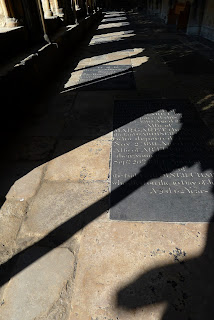"In the mountains of eastern Tibet, walking long miles through oak forests to reach Minya Konka, I set my pace to a Spanish palindrome on the subject of pilgrimage: La ruta nos aportó otro paso natural – "The path provides the natural next step". Its form cleverly acknowledges the transformative consequences of the pilgrimage, which turns the mind back upon itself, leaving the traveller both ostensibly unchanged and profoundly redirected."
A trip to Norwich Cathedral continued to develop my thoughts on walking as pilgrimage.
The quote from Robert Macfarlane above alludes once again to the idea of forward motion, of the rhythms of footsteps when walking that does something to connect us with our thought processes. In Norwich I was reminded that religion and its ritual has long understood this connection between the rhythms of walking and meditation.
Norwich Cathedral was a place of pilgrimage for centuries, attracting thousands to its walls. I am not aware of the paths that these pilgrims might have taken to reach here. However, walking the Cloisters of the cathedral, one can clearly feel the attitude of thoughtful perambulation that they were built for.
The very architecture of the Cloisters is built to evoke rhythms, to draw the walker on down the passageway (for me the image connects with Walter Benjamin's Parisian Arcades, an architecture for the religion of consumerism). The Cloisters form a circular route that can continue endlessly, extending the walk as long as it needs to be without ever leaving the building itself. The walker is allowed to connect with their internal meditations without interruption or being troubled by destination or navigation, merely allowing the repetitive motion of one foot in front of the other to continue rhythmically as long as is necessary.
In the centre of the cloisters is a low circular labyrinth. This is a new one, but an old idea; I have stumbled across many of these kind of labyrinths across the country. They were created for monks to walk the lines, twisting and turning as life itself, until reaching the central destination, a physical metaphor for the spiritual path through life to enlightenment. The labyrinth provides a form of pilgrimage for those devotees who cannot actually leave their location; a pilgrimage taking place in the mind through the physical walking of a delineated journey. (I walked one in York Minster where I had made an installation as part of Minster Nights 2009; as part of the event North Country Theater created a labyrinth in the Lady Chapel and invited people to walk the lines, then exchange a thought on paper dropped into a basket in the middle.)
This kind of walking is much like a chant, another repetitive and rhythmic form of meditation used by religious devotees. "La ruta nos aportó otro paso natural"




No comments:
Post a Comment